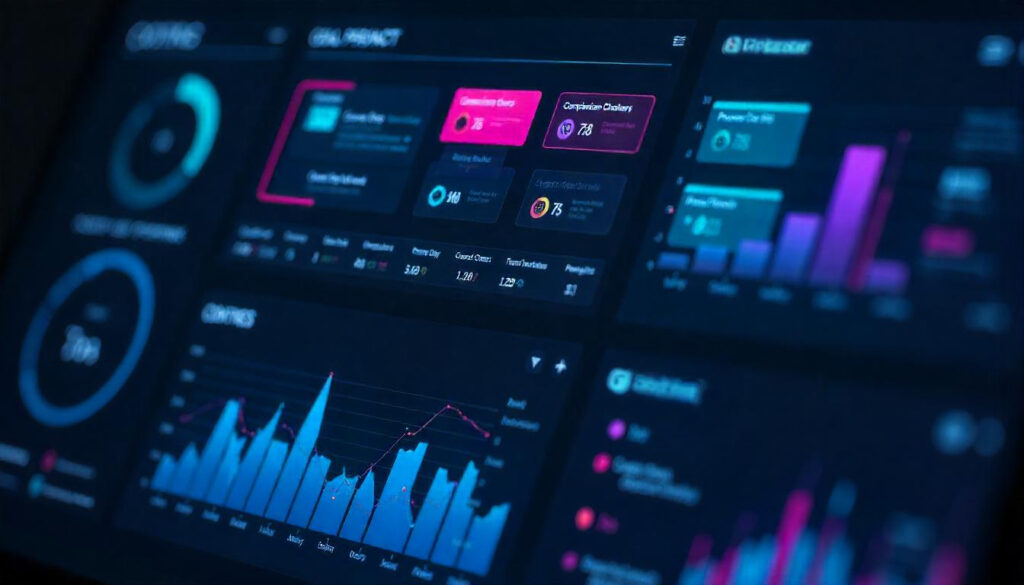The pressure on brands to deliver engaging, on-demand experiences is at an all-time high. The volume and velocity of content creation are growing exponentially, with research projecting that global data creation will reach 394 zettabytes by 2028. Amid this expansion, organizations are realizing that traditional digital asset management (DAM) systems must evolve into intelligent platforms that actively drive efficiency, creativity, and governance.
DAM insights enable smarter, more agile decisions across the entire content lifecycle. From automating metadata tagging with AI to enforcing brand compliance at scale, modern DAM strategies empower teams to move from reactive content management to proactive content orchestration. We’ll explore what makes a DAM platform “SMART” and how the right DAM insights can prepare your organization for what’s next.
What Are SMART DAM Insights?
The fast-evolving age of AI and always-on digital experiences is making users question whether their DAM system is indeed future ready. A static DAM system is no longer enough. Marketers and content teams need smarter, faster, and more scalable solutions to meet modern content demands.
SMART DAM insights are not just features—they form a framework for modern content success, and represent the only way forward for brands that want to compete in a world where content is your most valuable business asset. Built with five foundational pillars, SMART DAM connects content with audiences in meaningful, measurable ways:
S = Search. Find the right content faster with AI-powered, context-aware intelligent search capabilities that go far beyond filenames or folder structures. Advanced search tools include AI-powered Smart Tagging, visual and contextual search, Enhanced Captioning that increases discoverability, semantic search using natural language, and filtering with user-based configurations. Teams no longer waste time digging through folders or re-creating assets they couldn’t find.
M = Metadata. Power content discoverability and compliance with metadata automations that turn your asset data into a dynamic, automated engine for content control. Comprehensive metadata capabilities include Predictive Metadata enrichment using generative AI, Smart Tag Training to reflect brand-specific language, Optical Character Recognition (OCR) and Speech-to-Text for deeper indexing, hierarchical metadata relationships, and Digital Rights Management (DRM) rules. These automations not only help find assets but ensure they’re used correctly.
A = Advanced Insights. Know what’s working—and what’s not—with content intelligence analytics that provide deep, actionable insights into asset performance, usage, and engagement. While traditional DAMs end at content storage, SMART DAM allows teams to track asset engagement (views, shares, downloads, usage), identify top-performing assets by campaign or audience, discover underused content, and uncover DAM search trends and website content gaps to guide future creation.
R = Real-Time Personalization. Deliver content that adapts to your audience automatically. With SMART DAM, real-time personalization becomes part of the content operations layer, powered by AI that adapts to user behavior on the fly. The system tracks real-time behavioral signals, dynamically builds and updates behavioral segments, detects shifts in user intent, reorders content elements accordingly, and automatically surfaces the most relevant asset from the DAM to match that behavior.
T = Targeted Industry Solutions. Leverage tailored DAM capabilities for your unique industry challenges. SMART DAM includes modular, industry-specific capabilities for retail and consumer goods, manufacturing, financial services, life sciences, and more—ensuring that organizations can address vertical-specific challenges with precision.

5 Pillars of Intelligent DAM Insights for a Digital-First Strategy
Organizations that want to stay competitive need a strategic, insight-driven approach that connects people, processes, and technology. The SMART DAM insights framework empowers marketing, creative, and IT teams to move faster, stay aligned, and adapt with confidence. Let’s explore how each pillar enables more effective content operations across the entire lifecycle.
1. Automate Asset Management with Smart Search
Intelligent search transforms how teams find and utilize assets. One of the most powerful ways SMART DAM transforms workflows is through search capabilities that go far beyond basic keywords. With AI-powered DAM insights, teams can locate exactly what they need using natural language queries like “happy customer in a bank” instead of relying on exact metadata matches.
This isn’t just about speed—it ensures teams are using brand-safe, high-quality, and contextually relevant content without spending hours browsing folders or submitting asset requests. For organizations managing thousands or millions of assets, intelligent search reclaims countless hours of productivity while increasing content reuse.
In a financial services environment, where compliance, speed, and brand trust are paramount, intelligent search serves as both a convenience and a safeguard. Content strategists can instantly surface compliant images that match their campaign needs, even if those assets aren’t explicitly tagged with the exact terms.
2. Increase Content Discoverability with Metadata Automation
Metadata is the backbone of digital asset organization, but manual tagging creates bottlenecks and inconsistencies. SMART DAM turns metadata into a dynamic, automated engine for content control and discovery.
In the highly regulated world of life sciences, marketing and medical affairs teams are responsible for delivering high volumes of content—all of which must meet strict compliance standards. With SMART DAM, the burden of manual metadata tagging is replaced by intelligent automation.
Imagine a brand team uploading promotional materials for a new drug. As soon as the files enter the DAM, AI analyzes the content and automatically applies granular metadata including brand name, therapeutic area, target audience, mentioned side effects, brand colors, region, and regulatory classification.
The system doesn’t stop at basic tagging—it can detect missing safety statements or unbalanced risk/benefit information, automatically flagging assets for review before they ever reach the public. These intelligent triggers ensure compliance is proactive, not reactive—reducing the risk of costly regulatory oversights.

3. Power Digital Experiences with Advanced Insights
While traditional DAMs end at content storage, SMART DAM provides deep, actionable DAM insights into what content is performing. Content intelligence enables teams to track asset engagement, identify top-performing content, discover underused assets, and uncover content gaps to guide future creation.
For an e-commerce site selling consumer electronics, the Content Intelligence engine collects behavioral data across the customer journey and begins identifying dynamic user personas based on actual behavior. For instance, it might distinguish between “Deal Chasers” who focus on clearance sections and “Professional DJs” who engage deeply with high-end gear.
If the “Deal Chaser” segment is underperforming in conversions, content analytics might reveal a gap in contextual content like comparison charts or customer testimonials. Rather than waiting for a marketing manager to notice this manually, the system automatically flags the gap so teams can create what’s actually needed—with real-time data to back it up.
This level of insight transforms content operations from guesswork to strategic decision-making, ensuring creative resources are aligned with business outcomes.
4. Ensure Brand Safety and Compliance with Real-Time Personalization
Personalization has become non-negotiable in digital experiences, yet many organizations still rely on static segmentation models and manual testing. SMART DAM brings true real-time personalization into the content operations layer, powered by AI that adapts to user behavior instantly.
For digital publishers, maximizing reader engagement is everything. The challenge? Readers aren’t one-dimensional—their interests evolve session by session. With intelligent DAM insights, a news and media brand can move beyond basic segments and detect behavioral patterns that update in real time.
When a user engages with articles about renewable energy legislation, the platform identifies an emerging intent profile: “Environmentally-Conscious Reader.” In response, the homepage reorders featured stories, recommended sections update dynamically, and calls-to-action adapt to match the user’s interests. If they later engage with business content, their profile shifts to a blended model, allowing for more nuanced content delivery.
Behind the scenes, all surfaced assets are pulled directly from the SMART DAM. The AI doesn’t just identify user intent—it matches it with the best-performing, approved assets in the library, factoring in relevance, recency, brand rules, and even rights management data.
This capability ensures that personalization doesn’t compromise brand safety or compliance, as all content comes from the approved asset library rather than being generated on the fly.
5. Improve Lifecycle Management with Targeted Industry Solutions
Different industries face unique content challenges. The best DAM solutions include targeted capabilities for specific vertical markets, delivering industry-specific DAM insights that address unique requirements.
For retail and consumer goods companies, this means features like Product Content Management and Modular Content that automate creation and localization of promotional content, native integrations with e-commerce platforms, dynamic asset transformation, brand portals for retailers and franchisees, and campaign management tools.
Manufacturing organizations benefit from integration with PLM and PIM systems, support for 3D/CGI assets, workflow automation for global operations, and package dimension validation tools.
Financial services firms can leverage compliance workflows with FINRA/SEC checks, disclaimer management, robust Digital Rights Management, audit-ready logging, and support for WORM compliance required by financial regulators.
These industry accelerators reduce implementation time, improve adoption, and deliver faster ROI compared to generic DAM solutions.
Preparing for What’s Next: Future-Proofing with SMART DAM
The pace of change in digital content is accelerating, and expectations placed on marketing and creative teams are increasing. According to digital media trends, over 60% of consumers prefer personalized content experiences, while digital touchpoints continue to expand across platforms. Businesses relying on static or outdated asset management risk falling behind. The key to staying ahead lies in future-proofing your content operations with SMART DAM insights.
Future-ready asset management is about anticipating, not reacting. The SMART framework gives organizations visibility into how content is being used, which assets drive value, and where gaps exist. The digital asset management market is expected to grow from USD 5.3 billion in 2024 to USD 10.3 billion by 2029, reflecting the critical importance of these systems in modern content operations. Teams can make data-informed decisions about content investment and optimize based on evidence rather than guesswork.
Scalability is another component of future-proofing. As brands expand globally or adopt new channels, their DAM must keep pace, supporting new formats, languages, compliance rules, and distribution methods. A composable architecture ensures the DAM remains flexible and integrated, no matter how the tech stack evolves. Meanwhile, AI-powered features enable teams to do more with less, maintaining speed without sacrificing quality.
Preparing for what’s next means building a culture of continuous improvement. SMART DAM allows teams to benchmark performance, test new approaches, and iterate quickly. With intelligent workflows in place, creative and marketing operations can respond to new opportunities with agility, not delay.
Case in Point: How SMART DAM Drives Results
SMART DAM insights are delivering measurable business outcomes across industries. From speeding up asset creation to cutting operational costs, businesses embracing this AI-enabled approach are seeing tangible gains in performance, productivity, and scalability.
A global energy company implemented SMART DAM to streamline content creation across 70+ countries. By leveraging automated metadata tagging and AI-assisted asset reuse, they cut content creation time by 80% and reduced translation effort by half. The result was faster campaign execution without increasing headcount or budget.
A major home improvement retailer integrated SMART DAM capabilities to support millions of digital assets across thousands of campaigns. With real-time performance insights and modular content distribution, they efficiently managed peak seasons, handling over 4.5 million API calls per day while ensuring brand consistency.
One Fortune 500 medical device company used content automation to generate email and social media campaigns faster. By embedding AI-driven tools into their DAM workflows, they reduced time spent creating promotional content by over 70%, saving more than 27 hours per campaign and cutting costs by $20,000 on a single initiative.
These outcomes reflect a broader trend: when organizations move beyond basic asset storage and embrace SMART DAM, they unlock speed, scale, and strategic value. Whether improving campaign velocity, increasing asset reuse, or ensuring brand safety, SMART DAM offers a proven path to better performance and lower operational risk.

Takeaways for DAM Leaders
Digital asset management has matured from a functional necessity to a strategic lever for growth. For DAM leaders, storing assets is just the beginning. Leaders must also orchestrate the people, workflows, and technologies that bring content to life while ensuring brand consistency, compliance, and operational agility.
The key takeaway is this: intelligence is the new foundation of effective DAM. If your platform isn’t delivering real-time insights into asset performance, reuse, compliance status, or team productivity, you’re flying blind. SMART DAM insights offer the clarity and control needed to make better decisions, whether optimizing campaign timelines, reducing redundant production, or scaling personalized content.
Modern DAM leadership means adopting tools that:
- Enable better Search with AI-powered discovery
- Automate Metadata for enhanced governance and findability
- Provide Advanced Insights into content performance
- Deliver Real-Time Personalization based on user behavior
- Offer Targeted Industry Solutions for your specific business challenges
If your current solution lacks these capabilities, it may be time to re-evaluate what digital asset management means for your organization. The future belongs to DAM leaders who use content to drive outcomes.
Rethink What Your DAM Can—and Should—Deliver
The digital-first era demands more from every marketing and creative team. Content needs to be faster, smarter, and more personalized without increasing overhead or introducing brand risk. Relying on outdated systems won’t cut it anymore. To thrive, organizations must embrace SMART DAM insights.
When DAM becomes a strategic asset (not just a repository), it unlocks powerful advantages: intelligent search that saves time, automated metadata that increases governance, advanced insights that guide strategy, real-time personalization that drives engagement, and targeted solutions that address industry-specific challenges.
At Aprimo, we’ve built our platform to help organizations make that shift. Our AI-enabled SMART DAM delivers on all five pillars, empowering teams to transform how they create, manage, and activate content. We believe in giving you more than control over your content; we help you turn it into a competitive advantage. Contact us today to explore what’s next for your content strategy.


